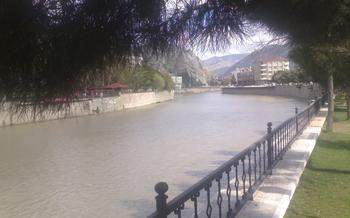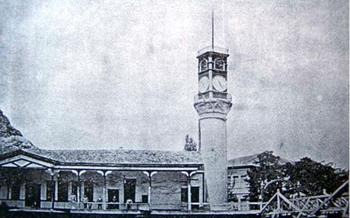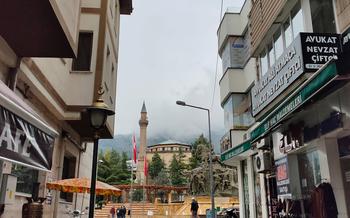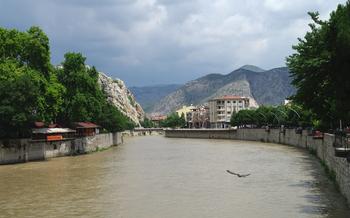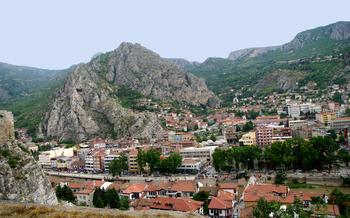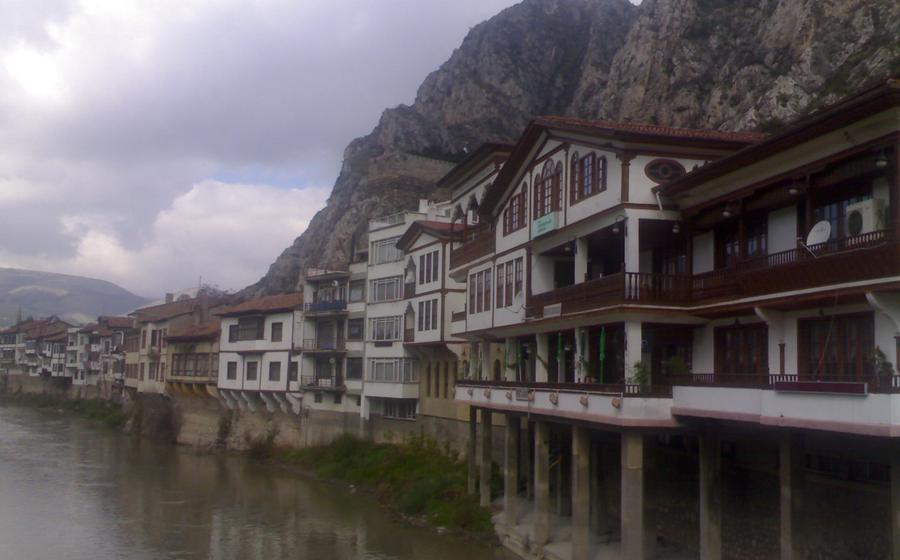
Şeyh Hamdullah Tomb
- History of the Şeyh Hamdullah Tomb
- Architectural Features
- Calligraphy and Art
- Historical Significance
- Cultural Importance
- Personal Experience: A Journey of Awe and Inspiration
- Local Cuisine
- Things to Do Nearby
- Photography Tips:
- Souvenirs and Shopping
- Travel Tips:
- Historical Context
- Local Festivals and Events
- Insider Tip: Unveiling Amasya's Hidden Gem
History of the Şeyh Hamdullah Tomb
The Şeyh Hamdullah Tomb stands as a testament to the legacy of one of the most renowned calligraphers of the Ottoman Empire. Şeyh Hamdullah, whose name translates to "Praised by God," was a master of the art of calligraphy, a revered scholar, and a respected teacher. He left an indelible mark on Islamic art and culture through his exceptional skills and contributions.
The tomb itself is a masterpiece of architectural significance, showcasing a harmonious blend of Ottoman and Seljuk architectural influences. Built-in the 16th century, the tomb reflects the cultural and artistic sensibilities of its time. It has become a prominent landmark in the city of Amasya, attracting visitors from around the world who seek to explore the rich heritage of Islamic art and calligraphy.
As a cultural heritage site, the Şeyh Hamdullah Tomb holds immense value. It represents the enduring legacy of Islamic art, showcasing the intricate and beautiful calligraphy that adorned manuscripts, Qur'ans, and other religious texts during the Ottoman era. The tomb serves as a reminder of the importance of calligraphy in Islamic culture, where it was not merely a means of writing but also an art form imbued with spiritual and aesthetic significance.
Amasya, the city where the tomb is located, has a rich and storied history dating back to ancient times. It was once the capital of the Pontus Kingdom and later became an important center of the Roman Empire. The city's strategic location on the banks of the Yeşil River made it a crucial trade and cultural hub, attracting diverse influences from various civilizations throughout history.
Architectural Features
The Şeyh Hamdullah Tomb stands as a testament to the harmonious blend of Islamic and Anatolian architectural styles. Its exterior facade captivates visitors with an ornate entrance gate, intricately carved with geometric patterns and verses from the Quran. The courtyard, adorned with a serene fountain, provides a tranquil space for contemplation and reflection. The minaret, a symbol of Islamic architecture, rises gracefully towards the sky, inviting the faithful to prayer.
Stepping inside the tomb, visitors are greeted by a breathtaking spectacle of intricate tilework and calligraphy inscriptions that adorn the walls and ceilings. The central dome, a masterpiece of engineering, allows natural light to filter through, casting a warm glow on the interior. The overall design of the tomb exudes a sense of balance and symmetry, reflecting the deep spiritual and aesthetic principles that guided its construction.
Each architectural detail holds profound symbolism and significance. The octagonal shape of the tomb represents the journey of the soul through different stages of spiritual development. The calligraphic inscriptions, penned in Şeyh Hamdullah's distinctive style, serve as reminders of the beauty and power of the written word. The intricate tilework, with its vibrant colors and geometric patterns, symbolizes the interconnectedness of all things in the universe.
Exploring the Şeyh Hamdullah Tomb is like stepping into a living testament to the rich cultural heritage of Turkey. Its architectural features, imbued with deep meaning and symbolism, offer a glimpse into the minds and hearts of the master builders and artisans who created this sacred space.
Calligraphy and Art
The Şeyh Hamdullah Tomb serves as a testament to the exceptional calligraphy skills of its namesake, Şeyh Hamdullah. Visitors can admire his renowned works, including Qur'anic inscriptions and decorative panels, which adorn the tomb's interior. These intricate creations showcase his mastery of the art of calligraphy, characterized by harmonious lines, elegant curves, and a deep understanding of the Arabic script.
In Islamic art and culture, calligraphy holds a revered position, transcending its functional purpose of writing. It is considered a sacred art form that reflects the beauty and perfection of the divine. Şeyh Hamdullah's calligraphy captures this essence, imbuing his works with a sense of spirituality and reverence.
Beyond calligraphy, the tomb also features other examples of art and craftsmanship, such as intricate tilework and decorative motifs. These elements contribute to the overall aesthetic appeal of the tomb, creating a harmonious blend of Islamic and Anatolian artistic traditions. The symbolism embedded in these artistic details provides insights into Ottoman culture and beliefs, offering a glimpse into the worldview of the period.
Historical Significance
The Şeyh Hamdullah Tomb holds immense historical significance as a testament to the life and achievements of Şeyh Hamdullah, a prominent figure in Ottoman history. As a renowned calligrapher and scholar, Şeyh Hamdullah left an indelible mark on the development of Islamic art and calligraphy during the Ottoman Empire. The tomb serves as a tangible connection to this influential period, providing insights into the cultural and intellectual climate of the time.
Beyond its association with Şeyh Hamdullah, the tomb also represents a broader narrative of Islamic heritage and cultural exchange. As an architectural masterpiece, it embodies the fusion of Islamic and Anatolian design elements, showcasing the rich artistic traditions of the region. The tomb's recognition as a UNESCO World Heritage Site further underscores its global significance, emphasizing its value as a cultural treasure that transcends national boundaries.
Visitors to the tomb can immerse themselves in the history and legacy of Şeyh Hamdullah, gaining a deeper appreciation for his contributions to Islamic art and calligraphy. The tomb stands as a reminder of the enduring power of artistic expression and the cultural exchange that has shaped the identity of the region throughout history.
Cultural Importance
The Şeyh Hamdullah Tomb holds immense cultural significance as a place of pilgrimage and reverence for admirers of Şeyh Hamdullah's work. Calligraphy enthusiasts from around the world visit the tomb to pay homage to the master calligrapher and witness his exceptional skills firsthand. The tomb serves as a living testament to the enduring legacy of Islamic calligraphy and the profound impact of Şeyh Hamdullah's contributions to this art form.
Beyond its religious and artistic significance, the tomb plays a vital role in preserving and promoting Islamic calligraphy as a cultural heritage. It serves as a repository of Şeyh Hamdullah's works and provides a platform for scholars and researchers to study and appreciate his contributions to Islamic art and calligraphy. The tomb's existence ensures that future generations can continue to learn from and be inspired by the master's exceptional craftsmanship.
Moreover, the tomb contributes to the cultural identity of Amasya, attracting visitors from Turkey and abroad who come to marvel at its architectural beauty and historical significance. The tomb's presence enriches the city's cultural landscape and fosters appreciation for local heritage. It serves as a symbol of Amasya's rich history and its role as a center of Islamic learning and culture.
Finally, the tomb promotes cross-cultural understanding and dialogue by showcasing the beauty and diversity of Islamic art and calligraphy. Visitors from different backgrounds and cultures come together to appreciate the universal language of art, transcending boundaries and fostering a sense of mutual respect and understanding. The tomb serves as a bridge between cultures, encouraging dialogue and promoting harmonious coexistence.
Personal Experience: A Journey of Awe and Inspiration
My visit to the Şeyh Hamdullah Tomb was a transformative experience that left an indelible mark on my soul. As I stepped through the entrance gate, I was immediately struck by the serene and hallowed atmosphere that enveloped the courtyard. The intricate tilework and graceful minaret reflected the harmonious blend of Islamic and Anatolian architectural styles.
Entering the tomb, I was awestruck by the exquisite calligraphy adorning the walls and ceiling. Şeyh Hamdullah's mastery of the art was evident in every stroke, capturing the essence of the written word with elegance and precision. His Qur'anic inscriptions and decorative panels exuded a sense of profound spirituality, inviting contemplation and introspection.
Standing in the hushed stillness of the tomb, I felt a deep connection to the past and a profound appreciation for the enduring legacy of Şeyh Hamdullah. His contributions to Islamic art and calligraphy have left an immeasurable mark on history, inspiring generations of artists and scholars.
Reflecting on my visit, I realized that the Şeyh Hamdullah Tomb is more than just a historical site; it is a living testament to the power of art, faith, and cultural heritage. It is a place where visitors can experience the beauty and depth of Islamic calligraphy, gain insights into the life and work of a legendary artist, and connect with the rich cultural tapestry of Turkey.
Local Cuisine
After exploring the Şeyh Hamdullah Tomb, visitors can savor the delights of Turkish cuisine at nearby restaurants or cafes. Amasya offers a range of culinary experiences, from traditional kebabs and pide to mouthwatering desserts.
For a taste of authentic Turkish cuisine, try the famous kebabs, grilled to perfection and served with fresh vegetables and aromatic spices. Pide, a boat-shaped flatbread filled with various toppings, is another local specialty not to be missed.
To satisfy your sweet tooth, indulge in the delectable künefe, a crispy shredded pastry filled with melted cheese and topped with sweet syrup. Baklava, a layered pastry filled with nuts and sweetened with honey, is another must-try dessert.
When it comes to restaurants, I highly recommend "Kebapçıoğlu," renowned for its succulent kebabs and pide. For a more casual dining experience, "Yemenli Konağı" offers a cozy ambiance and traditional Turkish dishes.
Whether you prefer a hearty meal or a sweet treat, Amasya's culinary scene has something to offer every palate. Embrace the opportunity to immerse yourself in the local flavors and make your visit to the Şeyh Hamdullah Tomb a truly memorable experience.
Things to Do Nearby
Beyond the Şeyh Hamdullah Tomb, Amasya offers an array of captivating attractions to enrich your visit. Delve into the rich history of the city at the Amasya Museum, housing an impressive collection of artifacts and exhibits showcasing the region's past. Admire the architectural grandeur of the Great Mosque, a stunning example of Seljuk architecture with its intricate tilework and elegant minarets.
For a breathtaking panorama of the city and its surroundings, embark on a scenic boat tour along the Yeşilırmak River. Glide past verdant landscapes, picturesque bridges, and ancient rock formations, capturing the essence of Amasya's natural beauty. Don't miss the opportunity to explore the many caves that dot the region, each with its unique geological formations and historical significance.
Immerse yourself in the vibrant local culture at the Amasya Bazaar, a bustling marketplace where you can haggle for traditional handicrafts, savor delectable Turkish cuisine, and experience the warmth and hospitality of the local people. For a taste of adventure, venture into the surrounding mountains, where you can hike through lush forests, encounter cascading waterfalls, and discover hidden gems off the beaten path.
Whether you seek historical exploration, natural wonders, or cultural immersion, Amasya offers an abundance of experiences to complement your visit to the Şeyh Hamdullah Tomb. Embrace the opportunity to delve deeper into the city's rich tapestry and create lasting memories in this enchanting destination.
Photography Tips:
Capturing the essence of the Şeyh Hamdullah Tomb through photography is a rewarding experience that allows you to preserve the memories of your visit and share its beauty with others. Here are some tips to help you take stunning photographs:
- Choose the Right Lighting:
-
Visit the tomb during the golden hours (sunrise or sunset) to take advantage of the warm, diffused light that enhances the colors and textures of the architecture.
-
Experiment with Angles:
-
Explore different angles to create unique and dynamic compositions. Try shooting from below to emphasize the grandeur of the dome, or from a distance to capture the tomb within its surroundings.
-
Use a Tripod:
-
A tripod ensures stability and helps avoid camera shake, especially when shooting in low-light conditions or using a telephoto lens.
-
Pay Attention to Details:
-
Focus on the intricate calligraphy inscriptions, tilework, and other decorative elements that adorn the tomb. Close-up shots can reveal the artistry and craftsmanship that went into its construction.
-
Capture the Atmosphere:
-
Take your time to observe the ambiance and atmosphere within the tomb. Photograph visitors paying their respects, or capture the play of light and shadow on the interior surfaces.
-
Share Your Photos:
- Share your best shots on social media using relevant hashtags or platforms, inspiring others to visit and appreciate the beauty of the Şeyh Hamdullah Tomb.
Souvenirs and Shopping
For those seeking a tangible reminder of their visit to the Şeyh Hamdullah Tomb and Amasya, there are several shops and markets nearby offering a variety of souvenirs and handicrafts. The Arasta Bazaar, located near the tomb, is a must-visit for its array of traditional Turkish handicrafts, including carpets, pottery, and jewelry. Here, visitors can browse and purchase unique items that showcase the local culture and craftsmanship.
Another popular shopping destination is the Amasya Çarşısı (market), where visitors can find a wide range of souvenirs, from traditional Turkish delights and spices to handmade souvenirs such as miniature replicas of the tomb or calligraphy-inspired artwork. Be sure to haggle for the best prices and enjoy the vibrant atmosphere of the market.
For those looking for authentic and high-quality souvenirs, the Şeyh Hamdullah Tomb Gift Shop is a great option. Here, visitors can find a curated collection of items inspired by the tomb and its history, including calligraphy prints, replicas of Şeyh Hamdullah's works, and books on Islamic art and calligraphy. The proceeds from the gift shop help support the preservation and maintenance of the tomb.
Whether you're looking for a unique souvenir to remember your visit or a meaningful gift for loved ones back home, the shops and markets of Amasya offer a diverse selection of items that capture the essence of this historic city.
Travel Tips:
To ensure a smooth and enjoyable experience in Amasya, here are some practical tips for travelers:
-
Accommodation options range from budget guesthouses to luxurious hotels. Research and book your accommodation in advance, especially during peak tourist seasons.
-
Amasya is well-connected by public transportation, including buses and minibuses. You can easily navigate the city using these affordable options. Taxis are also readily available.
-
The local currency is the Turkish Lira (TRY). Exchange your currency at reputable exchange bureaus or use credit cards for convenience.
-
When interacting with locals, it's polite to greet them with a friendly "Merhaba" (hello). A basic understanding of Turkish phrases can enhance your communication and show respect for the culture.
-
Amasya offers a variety of dining options, from traditional Turkish cuisine to international fare. Don't miss local specialties like kebabs, pide (Turkish flatbread), and keşkek (a hearty dish made with wheat, meat, and butter).
-
To create a comprehensive itinerary, allocate time to visit other must-see attractions in Amasya. These include the Amasya Castle, the Great Mosque, and the rock-cut tombs of the Pontic kings.
-
Embrace the local customs and traditions. Dress modestly when visiting religious sites, and avoid taking photos of people without their permission.
-
Share your travel experiences and photos on social media, using relevant hashtags like #Amasya, #TurkeyTravel, and #SheyhHamdullahTomb. Connect with fellow travelers and share your unique perspectives.
Historical Context
Amasya, a city nestled amidst the lush landscapes of northern Turkey, boasts a rich and storied past that spans several millennia. Its strategic location at the crossroads of ancient trade routes made it a coveted prize throughout history, attracting various civilizations and leaving an indelible mark on its cultural tapestry.
In the 4th century BC, Amasya fell under the rule of the Persian Achaemenid Empire, becoming a pivotal administrative center. The city's fortunes continued to rise during the Hellenistic era, as it served as the capital of the Kingdom of Pontus under the illustrious King Mithridates VI Eupator. His reign witnessed a flourishing of arts, culture, and scholarship, transforming Amasya into a prominent intellectual and cultural hub.
Following the Roman conquest in 64 BC, Amasya became an integral part of the Roman province of Galatia. Its strategic importance endured, as it served as a key military outpost and a vital link between the eastern and western regions of the empire. The city embraced Christianity during this period, becoming a significant center of early Christian thought and spirituality.
In the 11th century, Amasya fell under the sway of the Seljuk Turks, who left a lasting imprint on the city's architectural and cultural landscape. The Seljuks constructed magnificent mosques, madrasahs, and caravansaries, transforming Amasya into a thriving center of Islamic learning and culture. The city's architectural heritage from this era stands as a testament to the Seljuks' mastery of stonework and intricate ornamentation.
The Ottoman Empire, which rose to prominence in the 14th century, made Amasya its second capital, after Bursa. During this period, the city experienced a golden age, flourishing as a center of administration, arts, and commerce. The Ottomans embellished Amasya with stunning mosques, palaces, and bridges, leaving an indelible mark on its urban fabric. The city's strategic location along the Silk Road facilitated trade and cultural exchange, contributing to its cosmopolitan character.
Amasya's rich history is intricately intertwined with the stories of its inhabitants, who have shaped its cultural identity over the centuries. From ancient kings and scholars to Ottoman sultans and Sufi mystics, Amasya has been home to a diverse array of influential figures. These individuals have left their mark on the city's architecture, literature, music, and cuisine, creating a vibrant and multifaceted cultural heritage.
Today, Amasya stands as a living testament to its diverse past, with its numerous historical sites and cultural attractions drawing visitors from around the world. Its rich history continues to inspire and fascinate, inviting travelers to delve into the layers of this ancient city and discover its hidden treasures.
Local Festivals and Events
Amasya comes alive during its vibrant local festivals and events, offering visitors a chance to immerse themselves in the city's rich culture and traditions. The annual Amasya Cherry Festival, held in June, celebrates the region's famous cherries with parades, concerts, and traditional dances. In August, the Amasya International Music Festival fills the air with enchanting melodies from around the world, featuring performances by renowned musicians in historic venues. For a unique spiritual experience, attend the Mevlana Celaleddin-i Rumi Commemoration Ceremonies in December, which honor the renowned Sufi mystic with whirling dervish performances and devotional music. These events provide a glimpse into Amasya's diverse cultural heritage and create lasting memories for visitors.
Insider Tip: Unveiling Amasya's Hidden Gem
Beyond the renowned attractions of Amasya, there lies a hidden gem waiting to be discovered. Nestled amidst the picturesque alleys of the old town, just a short stroll from the Şeyh Hamdullah Tomb, you'll find a secret garden known as the "Gizli Bahçe." This enchanting oasis, tucked away from the bustling streets, offers a tranquil haven for weary travelers and locals alike.
To find the Gizli Bahçe, look for an unassuming doorway adorned with intricate carvings. Step through the doorway and follow the winding path, surrounded by lush greenery and fragrant flowers. As you delve deeper into the garden, the noise of the city fades away, replaced by the gentle sound of birdsong and the rustling of leaves.
At the heart of the garden lies a charming teahouse, where you can sip on traditional Turkish tea or indulge in sweet Turkish delights. Take a moment to relax and soak in the serene atmosphere, surrounded by the beauty of nature.
The Gizli Bahçe is a true hidden gem of Amasya, offering a unique and authentic experience. Whether you're seeking a peaceful retreat or a chance to connect with the locals, this enchanting garden is a must-visit for those who seek to discover the hidden treasures of this historic city.


